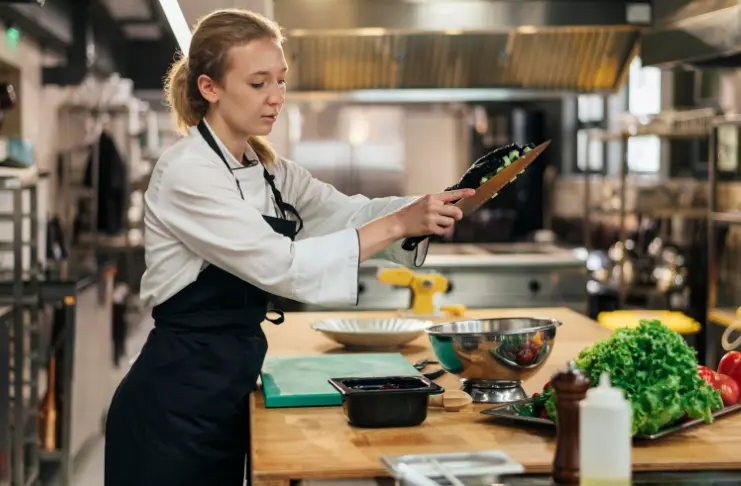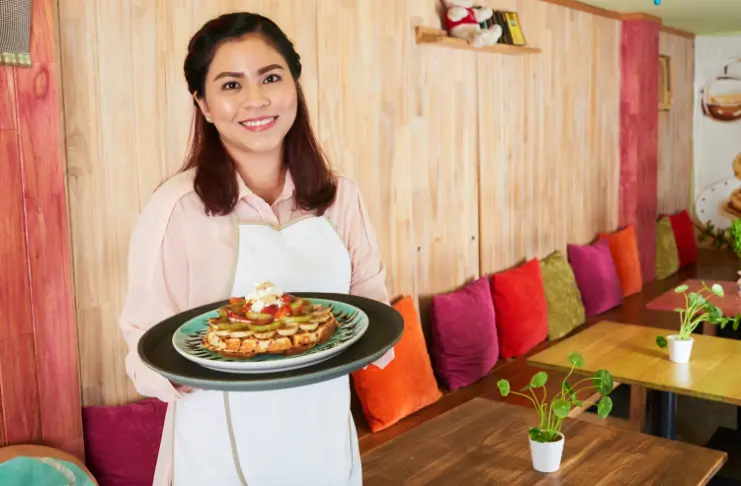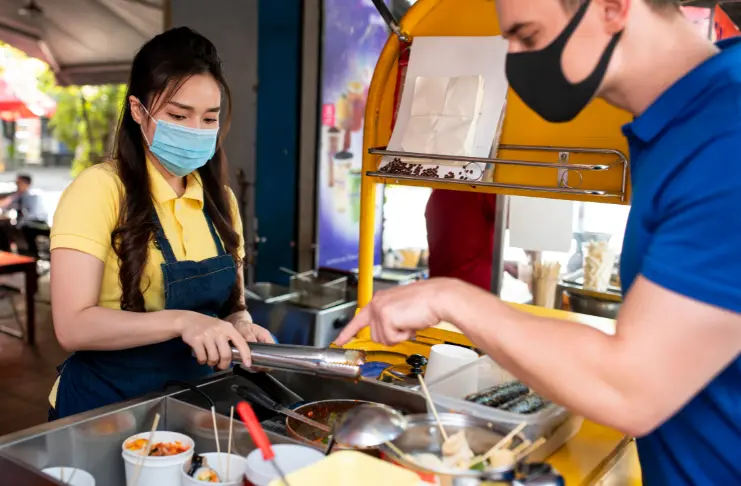Here’s a hard truth: it doesn’t matter how great your food tastes if you can’t price it right.
In a market affected by inflation, rent spikes, and unreliable suppliers, keeping track of your food costs is often the first line of defense. Yet, too many restaurant owners eyeball it. They think, “We’re busy. We must be doing fine.” But volume means nothing if your pasta dish is eating your margins alive.
This is where understanding the food cost formula in restaurant comes in handy. It tells you about your expenditure, how much it should be, and how you can build pricing that keeps your business profitable, even when costs fluctuate.
What Is Food Cost & Why Does It Matter

Food cost refers to the total expenses incurred in preparing the food you serve, including its ingredients, labor, and overhead costs.
It’s an important metric for restaurants because it directly affects profitability. If you don’t know where your money’s going, you can’t fix the leaks in your kitchen or on your menu. And that’s the first reason why it matters.
Other reasons include:
- Pricing Accuracy: Without accurate food cost data, you might undervalue your dishes or overprice them, both of which can drive away customers or shrink your margins.
- Waste Reduction: Tracking food costs helps you monitor waste, whether from over-ordering, spoilage, or inefficient prep.
- Cost Control: Your ability to control food costs determines whether you can weather rising supply costs, inflation, or unexpected disruptions in the supply chain. The right food cost formula will keep you nimble and profitable, no matter what.
How to Calculate Food Cost?

Now that you understand why food cost is essential, let’s break down how to calculate it accurately. The process involves understanding your restaurant’s food inventory, tracking food purchases, and calculating waste, all of which impact the final number.
Step 1: Calculate Beginning Inventory
Before calculating your food costs for a specific period, you must know where you started. This will take you to your beginning inventory, which is simply the total value of your food supplies on hand at the start of the period.
To calculate your beginning inventory:
- Review your records or use a restaurant POS system.
- Record the total value of your ingredients as of the beginning of the accounting period (e.g., the start of the month).
For example, if you started the month with $5,000 worth of ingredients, that’s your beginning inventory.
Step 2: Add Purchases During the Period
Next, add all the purchases you’ve made during the accounting period, whether for ingredients, beverages, packaging, or other food-related supplies. These are your inventory purchases.
For example, if you spent $12,000 on food supplies during the month, add it to your beginning inventory to get your total available inventory for the period.
Step 3: Calculate Ending Inventory

The ending inventory refers to the total value of the food on hand at the end of the period. This gives you the final stock count for the period after all ingredients have been used and food waste has been accounted for.
To calculate your ending inventory:
- Again, use your POS system or manually track stock and prices.
- Subtract the amount of food used from the total you had at the beginning, plus any new purchases.
If, at the end of the month, your inventory is worth $4,000, then that’s your ending inventory.
Step 4: Calculate Total Food Cost
Now, it’s time to calculate the total food cost for the period.
Use this formula:
Total Food Cost = Beginning Inventory + Purchases − Ending Inventory
Using the numbers from earlier:
- Beginning Inventory = $5,000
- Purchases = $12,000
- Ending Inventory = $4,000
Total Food Cost = 5,000+12,000−4,000 = 13,000
So, in this example, your monthly food cost is $13,000.
Step 5: Calculate Food Cost Percentage
To better understand how food costs affect your restaurant’s finances, you need to calculate the food cost percentage. This is the ratio of food expenses to the revenue generated from food sales. It indicates how well you manage food-related expenses and whether you need to adjust your menu or prices.
Its formula is simple:
Food Cost Percentage = (Total Food Sales/Total Food Cost)×100
Where:
- Total Food Cost is the cost of all ingredients used in a given period (e.g., weekly or monthly)
- Total Food Sales is the revenue from food sales in the same period
For example, if your restaurant’s food costs for the month were $10,000 and your total food sales were $30,000, your food cost percentage would be:
(10,000/30,000)×100=33.33%
This means that for every dollar earned from food sales, 33 cents went toward covering food costs.
Ideal Food Cost Percentage

There’s no universal ideal food cost percentage. It varies based on your restaurant type, pricing strategy, and location. However, most restaurants aim for a food cost percentage between 28% and 35%.
Why this range?
- Higher percentages could signal inefficiency, over-ordering, or pricing mistakes.
- Lower percentages may indicate you’re cutting corners on quality or underpricing your menu.
Understanding your ideal food cost percentage helps you adjust prices, tweak portion sizes, and choose the right suppliers to balance quality and profitability.
Step 6: Track & Analyze Food Costs Regularly
While calculating food cost at the end of the period is important, ongoing tracking is key to staying on top of your margins. Use your restaurant’s POS system to track sales and inventory in real time.
Regular analysis will help catch issues early and rectify them on the go.
Optimize Your Food Cost Calculation
Your goal should be to keep your food costs as low as possible without sacrificing quality.
Consistently calculating food costs, comparing them against sales, and identifying inefficiencies will put you in control of your restaurant’s profitability.
But the question is: How can you optimize your food costs? Here you go.
How to Optimize Food Cost Percentage Without Compromising Quality

Whether you’re operating a fine-dining restaurant or a fast-casual kitchen, maintaining an ideal food cost percentage is your key to protecting margins while still delivering a great guest experience. Here’s how you can do it right:
Set Your Ideal Food Cost Percentage
Before you can optimize, you need a target. As mentioned, the most profitable restaurants aim for a food cost percentage between 28% and 35%, depending on their concept and cuisine.
Use this formula to reverse engineer your menu prices:
Selling Price = Cost Per Serving/Ideal Food Cost Percentage
So if your cost per serving is $5 and your target ideal food cost percentage is 30%, your menu price should be:
5/0.30=16.67
If you’re pricing that dish at $12, you’re losing money. Pricing it at $17 gives you healthy margins.
Standardize Portion Sizes Across Menu Items

Inconsistent portion sizes are one of the fastest ways to wreck your actual food cost. You need to standardize recipes and train staff to portion by weight, not by eye.
- Use kitchen scales, scoops, and ladles for consistency.
- Audit plating during service to reduce food waste and cost creep.
Even a 10g overserve on a high-cost protein can add up to thousands of dollars lost each month.
Engineer Your Menu Around Margin, Not Just Popularity
Menu design is a strategic tool. Start with a menu matrix that maps items across popularity vs. profitability. Then:
- Highlight high-margin menu items with visual cues.
- Downplay or remove low-margin, low-popularity dishes.
- Consider ingredient overlap to reduce your inventory costs.
Guide your customers’ eyes to items that boost your profit margins.
Audit Weekly Inventory to Tighten Accuracy
Don’t rely on monthly checks. Weekly inventory value tracking will help you spot issues like these early:
- Theft or misreporting.
- Overstocking perishables.
- Leftover inventory from over-ordering.
Keep tabs on beginning inventory, purchases, and ending inventory every seven days. This will also sharpen the accuracy of your total food cost percentage.
Renegotiate with Vendors & Optimize the Supply Chain

If your food costs are rising, your vendor relationships should evolve, too. Here’s what you should be doing:
- Compare inventory purchases across multiple suppliers.
- Negotiate bulk discounts or locked pricing on staples.
- Audit food supplies for waste and spoilage rates.
Sometimes, your actual costs aren’t coming from the invoice; they’re hiding in inefficiencies downstream.
Track Yield and Prep Losses
Just because you buy 10 kg of onions doesn’t mean you’re using 10 kg.
- Calculate yield percentages for each ingredient.
- Track what’s lost during prep and what’s left over post-service.
If 30% of your fish gets trimmed away before it hits the plate, your cost per serving is higher than you think.
Automate Food Cost Tracking With Tech

Upgrade to a POS-integrated system that tracks total sales, food inventory, and cost of goods sold in real time.
- Automate alerts for unusual usage spikes.
- Link purchases with menu costs to spot trends.
- Track food cost margins against actual sales data.
Price Smart, Not Low
Trying to compete on price alone is a race to the bottom. Instead:
- Bundle slow-moving ingredients into specials.
- Use strategic upsells (e.g., add-ons, size upgrades).
- Offer high-margin drinks or sides to balance tighter entrées.
Remember: Effective pricing strategy is about value perception, not just price tags.
Common Food Cost Mistakes That Quietly Destroy Restaurant Margins

Most restaurants don’t lose money on big mistakes. They leak profit silently, dish by dish, day by day, because no one’s watching the numbers closely enough. For example:
1. Thinking Busy Means Profitable
Many operators fall for this trap: “We’re packed, so we must be doing well.” But without tracking your food cost, that’s just a dangerous assumption. High volume doesn’t always translate to high margins, especially if your signature pasta dish is running at 42% food cost. Multiply that across hundreds of plates a week, and you’re losing money at scale.
INDUSTRY INSIGHT
| An article highlights how 73% of business data goes unanalyzed, often leading to a phase where they “drown in data but starve for insights.” This underscores the importance of collecting data and actively analyzing it to make informed decisions. In the context of a restaurant, this reiterates that being busy is only beneficial if your financial metrics support it. |
2. Not Tracking Waste or Over-Portioning
Without daily waste logs or portioning discipline, even a well-designed menu can lead to an inflated actual food cost percentage. Over-trimmed proteins, accidental double servings, or expired ingredients quietly eat into your margins.
Top-performing kitchens often run daily line checks and use precision scales during prep, not because they micromanage, but because they understand that consistency protects profits.
3. Using Outdated Ingredients Costs

What was the ideal food cost you calculated last year? It probably doesn’t hold true anymore. Inflation has turned ingredient pricing into a moving target.
Yet, many restaurants still base their menu prices on historical costs, leading to shrinking profit margins without even realizing it. Items like avocados, cheese, and seafood can fluctuate wildly monthly. Operators who regularly update recipe costs based on current purchase data maintain healthy food cost margins.
4. Taking Inventory Too Infrequently
If you only do inventory value checks once a month, you’re reacting too late. Weekly inventory is essential for spotting discrepancies, catching shrinkage, and monitoring overuse.
Let’s say your ending inventory for chicken consistently runs low despite stable sales; that could point to portioning errors or theft. Weekly checks linked to your restaurant’s POS allow for faster course correction and tighter food cost control.
Conclusion
Understanding and using the right food cost formula in restaurant operations ensures your restaurant maintains healthy profit margins while delivering value to your customers. Regular monitoring, attentive management, and strategic adjustments are key to keeping food costs within target ranges.
Frequently Asked Questions
1. What is the formula for desired food cost?
The formula for desired food cost is: Desired Food Cost Percentage = (Ideal Food Cost / Total Food Sales) × 100
This formula helps you set a pricing target that maintains profitability based on your menu costs and projected revenue.
2. How do you calculate food cost per portion?
To calculate food cost per portion, divide the total cost of ingredients used by the number of portions it yields:
Food Cost Per Portion = Total Cost of Ingredients / Number of Portions
3. How do you calculate cost per unit of food?
You can calculate it by dividing the total cost of a food item (including waste and trim) by its weight, volume, or unit count.
Cost Per Unit = Total Ingredient Cost / Units Purchased
4. What is the rule of thumb for food cost?
For most restaurants, the rule of thumb is to keep food cost percentage between 28% and 35% of total sales. However, this can vary based on concept, cuisine, and region.
5. What is the formula for calculating food cost?
The standard formula is:
Food Cost Percentage = (Beginning Inventory + Purchases – Ending Inventory) / Food Sales × 100
6. How to calculate the cost of homemade food?
List all ingredients and their quantities. Calculate their cost based on the purchase price, and divide by the total servings. Remember to account for electricity, gas, and prep time if needed.
7. What is the meaning of food cost?
Food cost refers to the total cost of all ingredients used to prepare the food you sell. It’s a vital metric for tracking profitability and controlling expenses.
8. What does 30% food cost mean?
This means 30% of your food sales revenue is spent on ingredients. For example, if you sell a dish for $10, $3 goes into food supplies, and $7 covers other costs and profit.
9. How do you calculate food cost?
Food cost is calculated by: (Beginning Inventory + Inventory Purchases – Ending Inventory) / Total Food Sales × 100
10. What is food cost and why is it important?
Food cost is the amount spent on ingredients relative to the revenue from food sales. It’s crucial because high food costs can affect profit margins, while low costs may affect quality.
11. How do you calculate food cost percentage?
To calculate the food cost percentage, use this formula: (Cost of Goods Sold / Total Food Sales) × 100
12. What is the ideal food cost ratio?
While it depends on your concept and business model, most full-service restaurants aim for an ideal food cost ratio between 28% and 35%. For fast food or QSRs, it could go even lower.
13. What is food to cost ratio?
This is the inverse of the food cost percentage. It reflects how much food revenue you generate for each dollar spent on food.
Food-to-Cost Ratio = Food Sales / Food Cost





